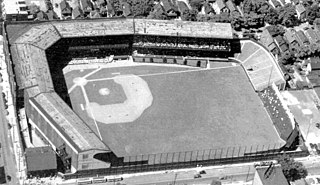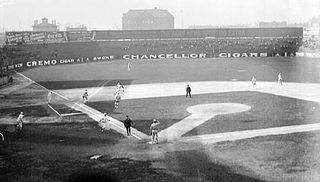Related Research Articles

League Park was a baseball park located in Cleveland, Ohio, United States. It was situated at the northeast corner of Dunham Street and Lexington Avenue in the Hough neighborhood. It was built in 1891 as a wood structure and rebuilt using concrete and steel in 1910. The park was home to a number of professional sports teams, most notably the Cleveland Indians of Major League Baseball. League Park was first home to the Cleveland Spiders of the National League from 1891 to 1899 and of the Cleveland Lake Shores of the Western League, the minor league predecessor to the Indians, in 1900. From 1914 to 1915, League Park also hosted the Cleveland Spiders of the minor league American Association. In the late 1940s, the park was also the home field of the Cleveland Buckeyes of the Negro American League.

Griffith Stadium stood in Washington, D.C., from 1911 to 1965, between Georgia Avenue and 5th Street, and between W Street and Florida Avenue NW.

National League Park, commonly referred to as the Baker Bowl after 1923, was a baseball stadium and home to the Philadelphia Phillies from 1887 until 1938, and first home field of the Philadelphia Eagles from 1933 to 1935. It opened in 1887 with a capacity of 12,500, burned down in 1894, and was rebuilt in 1895 as the first ballpark constructed primarily of steel and brick, and first with a cantilevered upper deck.

South Side Park was the name used for three different baseball parks that formerly stood in Chicago, Illinois, at different times, and whose sites were all just a few blocks away from each other.

Washington Park was the name given to three Major League Baseball parks on two different sites in the Park Slope neighborhood of Brooklyn, New York, located at the intersection of Third Street and Fourth Avenue. The two sites were diagonally opposite each other, on the southeast and northwest corners.

Ridgewood Park, also known as Wallace's Ridgewood Park or the Wallace Grounds, and frequently confused with Grauer's Ridgewood Park, was a baseball ground in Ridgewood, Queens, New York. Both Wallace's and Grauer's are shown in Belcher Hyde's Map of Newtown in 1915. The baseball field was part of a larger entertainment area bounded Wyckoff Avenue, Covert Street, Halsey Street, and Irving Avenue. The baseball field was southwest of the Long Island Rail Road's Montauk Branch tracks. Eldert Street, although depicted on the map as running through the baseball grounds, was not cut through southwest of the railroad tracks and the road remains interrupted there today. Originally the park was in Queens County, before its incorporation into New York City in 1899. This facilitated Sunday baseball playing, including the charging of admission, beyond the reach of Sabbath enforcers from the then-city of Brooklyn.

Sulphur Dell, formerly known as Sulphur Spring Park and Athletic Park, was a baseball park in Nashville, Tennessee, United States. It was located just north of the Tennessee State Capitol building in the block bounded by modern-day Jackson Street, Fourth Avenue North, Harrison Street, and Fifth Avenue North. The ballpark was home to the city's minor league baseball teams from 1885 to 1963. The facility was demolished in 1969.

Pelican Stadium, originally known as Heinemann Park (1915–1937), was a sports stadium in New Orleans, Louisiana from 1915 to 1957.
Harrison Park is a former baseball ground located in Harrison, New Jersey, a town adjacent to Newark, New Jersey. The ground was home to the Newark Peppers of the Federal League in 1915. The field was also known as "Peppers Park" or "Peps Park". In publications such as city directories and newspapers, it was often called Federal Baseball Park even during its International League days.

J. P. Small Memorial Stadium is a baseball park in Jacksonville, Florida. It is located in the Durkeeville community in northwest Jacksonville. Constructed in 1912 and rebuilt in 1936, it was the city's first municipal recreation field, and served as its primary baseball park before the construction of Wolfson Park in 1954. Throughout the years the stadium has been known at various times as Barrs Field, Durkee Field, and the Myrtle Avenue Ball Park.
The P.R.R. YMCA Athletic Field, also known as Penmar Park and commonly referred to in the 1930s and 1940s as the 44th and Parkside ballpark, was an athletic field and ballpark in West Philadelphia from as early as the 1890s to the early 1950s. It was built by the Pennsylvania Railroad YMCA for use by its employees. Behind the right-field fence stood the roundhouse of the main yard of the Pennsylvania Railroad. The Negro league baseball Philadelphia Stars played home games at the park from 1936 until 1952.

West End Park was a baseball park in Houston from 1905 to the 1940s. It was the primary ballpark for the city when it was constructed, and the city's first venue for Negro Major League games. From 1909 through 1910 and again in 1915, it also served as the spring training facility of the St. Louis Browns as well as the 1914 New York Yankees of the American League and the 1906 through 1908 St. Louis Cardinals of the National League in Major League Baseball. After its use by its primary tenant, the Houston Buffaloes of the Texas League, the ballpark was sold to what is now known as the Houston Independent School District for its use until it was demolished.
References
- ↑ Jonathan Goldman (October 1, 2021). "Revisiting Dyckman Oval, A Lost Landmark From the Heyday of Black Baseball". Atlas Obscura.
- Peter Filichia, Professional Baseball Franchises, Facts on File, 1993.
- Benson, Michael (1989). Ballparks of North America: A Comprehensive Historical Reference to Baseball Grounds, Yards, and Stadiums, 1845 to present. Jefferson, N.C.: McFarland. ISBN 0-89950-367-5.
- Lowry, Philip J. (1992). Green Cathedrals: The Ultimate Celebration of All 271 Major League and Negro League Ballparks Past and Present . Reading, Massachusetts: Addison-Wesley. ISBN 0-201-56777-6.